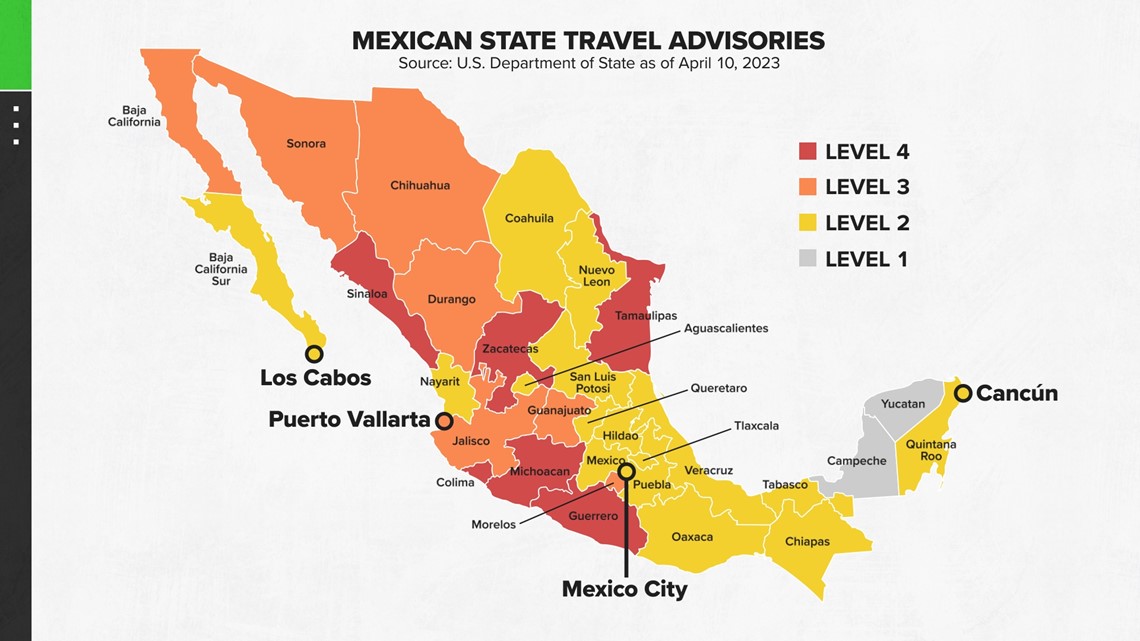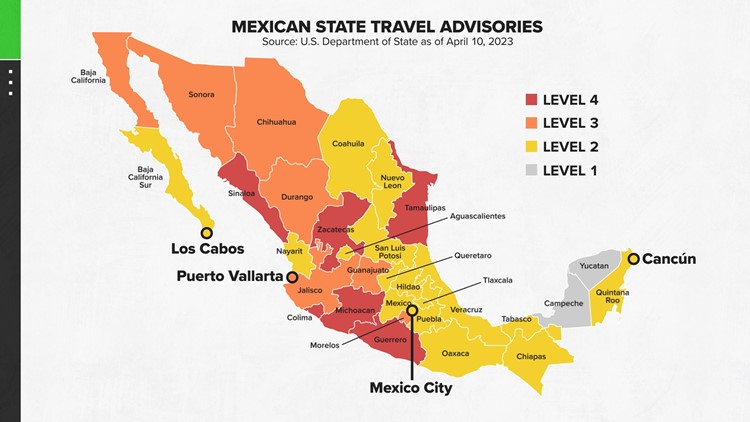Mexico is a popular vacation destination for Americans. This year, in a review of flight itineraries for spring break trips between five and eight days, Allianz Travel Insurance found that four of the top 10 international spring break destinations are in Mexico. The number one international city on the list is Cancun.
Recent headlines about crime in Mexico resulting in American tourists being injured or even killed has led some travelers to worry about their safety when considering trips across the southern border. Hazel emailed VERIFY to ask if it was dangerous for Americans to travel to certain parts of Mexico. Travel safety questions about Mexico and its cities are popular on Google search, so VERIFY is answering some of the most common ones.
THE SOURCES
WHAT WE FOUND
The U.S. Department of State issues travel advisories for every country in the world, alerting American citizens traveling abroad of safety risks in those places. It handles Mexico slightly differently, issuing advisories for individual states and Mexico City instead of an advisory for the whole country.
These travel advisories range from level 1 to level 4, with level 1 being the least severe and level 4 being the most severe. You can exercise normal precautions in level 1 places, you should exercise increased caution in level 2 places, you should reconsider travel to level 3 places and you should not travel to level 4 places.
The State Department says “crime, terrorist activity, civil unrest, health, natural disaster/weather and current events” all factor into how it determines the level of travel advisory issued. As part of these travel advisories, the State Department also issues travel restrictions for federal employees and recommends tourists adhere to this guidance.


What parts of Mexico are deemed unsafe to travel to?
There are 32 states, including Mexico City's capital district, in Mexico; only two have a level 1 advisory from the U.S. State Department.
Six of these states have level 4 “Do Not Travel” warnings: Colima, Guerrero, Michoacan, Sinaloa, Tamaulipas and Zacatecas. In Guerrero, federal employees are permitted to stay in downtown tourist areas of Taxco, but may not travel to other parts of the state including Alcapulco, Zihuatanejo and Ixtapa. Federal employees may travel to Morelia in Michoacan, but are not permitted to travel to the rest of the state, including the parts of the Monarch Butterfly Reserve within the state. The State Department also restricts travel within Mazatlán to the Zona Dorada and historic town center, and does not permit travel to other areas in Sinaloa state.
The State Department gave all six states level 4 advisories because of widespread crime, as well as high rates of kidnapping in all states but Guerrero.
Tamaulipas is on the U.S. border, along the Gulf Coast. The four Americans kidnapped in March were in Tamaulipas when their vehicle came under fire, the U.S. Embassy in Mexico says. They had recently crossed the border from Brownsville, Texas, into Matamoros.
Seven more states have level 3 “Reconsider Travel” warnings: Baja California, Chihuahua, Durango, Guanajuato, Jalisco, Morelos and Sonora. There are no restrictions on travel for federal workers in high-traffic tourist areas of Baja California, including in Tijuana, Ensenada and Rosarito, although the State Department expressed concerns with “the high number of homicides in the non-tourist areas of Tijuana.” Federal employees are forbidden from traveling to Copper Canyon in Chihuahua.
The State Department doesn’t have travel restrictions for any other tourist areas in level 3 states, including San Miguel de Allende and Guanajuato City in Guanajuato, and the Guadalajara metropolitan area and Puerto Vallarta in Jalisco.
Baja California, Sonora and Chihuahua make up the western half of the U.S.-Mexico border.
All but two of the remaining states have level 2 “Exercise Increased Caution” warnings because of high crime rates. Tourist areas within the level 2 states include: Cancun, Cozumel, Tulum and Playa del Carmen in Quintana Roo; Mexico City; Teotihuacán in Mexico State; Los Cabos in Baja California de Sur; and Nuevo Vallarta in Nayarit. The State Department does not restrict travel for employees to any of these tourist areas.
The two states with level 1 “Exercise Normal Precautions” advisories are Campeche and Yucatan. Chichen Itza, Uxmal and Mérida are in Yucatan
Are Cancun and other popular tourist towns safe?
The British government says Mexico works to protect major tourist destinations. Still, “those areas have not been immune to the types of violence and crime experienced elsewhere in Mexico,” the U.S. State Department says.
Although they’re not completely crime-free, the tourist zones of popular destinations are generally safer than other parts of those cities. The Canadian government tells its citizens to stay in tourist areas if they’re traveling to Mexico. The State Department recommends travelers avoid downtown Cancun, Tulum and Playa del Carmen after dark, and instead stay in tourist areas and along well-lit pedestrian streets.
Cancun welcomes the most international travelers to its airport than any other city in Mexico, as much as two to three times more than the next most popular destination, Mexico City. Since Cancun is particularly popular, the State Department and other officials typically give specific advice for travel to Quintana Roo, which also includes Tulum, Playa del Carmen and the Riviera Maya.
The State Department has issued a level 2 advisory for Americans, recommending travelers exercise increased caution while in Quintana Roo, due to crime and kidnapping concerns. There is currently an increased police presence in the Cancun area, including in the city’s Hotel Zone, the British government says.
The State Department, British government and the Overseas Security Advisory Council (OSAC), an American public-private international security partnership for U.S. companies and organizations, all agree that while tourists aren’t commonly targeted by criminal organizations in Quintana Roo, there have been incidents in which tourists have been injured or killed after being caught in the crossfire of rival groups.
The State Department also advises that travelers to Mexico City and the surrounding State of Mexico remain vigilant.
“Use additional caution, particularly at night, outside of the frequented tourist areas where police and security patrol more routinely,” the State Department says of Mexico City. “Petty crime occurs frequently in both tourist and non-tourist areas.”
Do criminals in Mexico target tourists?
Thousands of U.S. citizens visit Mexico during spring break each year, and the vast majority travel safely, the U.S. Embassy in Mexico says. Officials say criminal groups like cartels or gangs are unlikely to actively target travelers. Still, just like in other popular tourist destinations, someone who makes it obvious they’re carrying around a lot of money can become an easy mark for a petty thief.
Tourists who travel smart by staying aware of their surroundings and not calling attention to themselves will make themselves less likely to be targets.
“Although there is no evidence of criminals specifically targeting foreign or U.S. businesses and personnel, criminals will target victims based on the appearance of affluence, vulnerability or lack of awareness,” OSAC says. “Regarding cartel violence, wrong-place/wrong-time incidents present the greatest threat to personal safety.”
The Canadian government warns there have been incidents in which robbers in Mexico follow a victim after they exchange or withdraw money at airports, currency exchange bureaus (casas de cambio) or ATMs. It suggests travelers avoid withdrawing or exchanging money in public or easy to see areas of the airport.
Robberies and assaults on passengers in taxis not affiliated with a taxi stand are also common, the State Department says. Rather than hail taxis on the street, tourists should use regulated taxi stands or an application-based service like Uber or Cabify.
A hurried cash transaction on the street can leave a traveler fleeced with shoddy or counterfeit goods, out-of-circulation valueless currency or incorrect change, OSAC says. Tourists can also be victims of ATM skimming crimes and credit card fraud.
“Try to use ATMs in bank branches during business hours,” OSAC recommends. “Portable credit card terminals are widely available in Mexico; always request that the establishment bring a portable credit card terminal to charge a credit card in your physical presence.”
Is it safe to drive into Mexico instead of flying?
Travelers shouldn’t drive into Mexico to get to their destination, the State Department says. Fly or arrive by ship instead.
The State Department restricts certain travel for U.S. government employees within Mexico, and recommends U.S. citizens adhere to these restrictions, too. Government employees, and therefore American travelers generally, should not drive from the U.S. border into interior parts of Mexico.
Many criminal organizations are particularly active near the border, contributing to the high level travel advisories issued to all of the country’s border states. These states are key locations for international drug trade and human trafficking networks, the State Department says.
The State Department advises against traveling by road at all in some states, except for a few highways and cities. U.S. government employees are only permitted to travel to some cities by air or sea, and not by road.
Cancun and other nearby resort towns are among the farthest Mexican cities from the U.S. border by road, based on Google Maps travel times. Any American driving to those resort towns would have to travel through areas of restricted travel to get there.
When driving, the State Department recommends the use of toll roads when possible, and to avoid driving at night — especially when traveling between cities. Americans should avoid traveling alone while in Mexico, particularly in remote areas.


